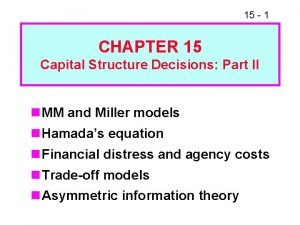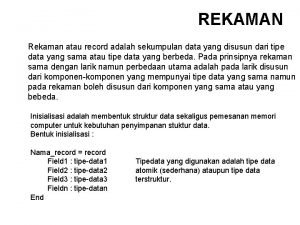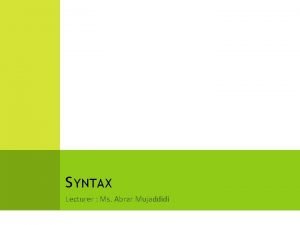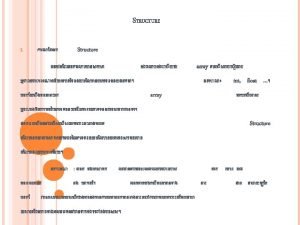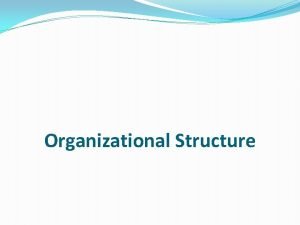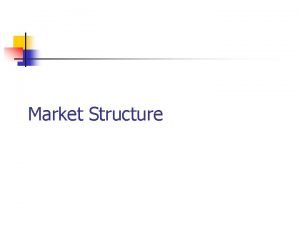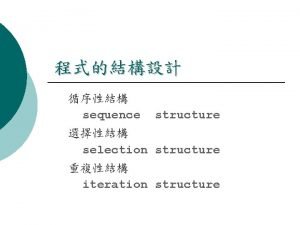Structure of Presentation Part 1 Part 2 Part




































- Slides: 36


Structure of Presentation Part 1 Part 2 Part 3 2 • State of Financial and Capital Markets Before the Subprime Loan Crisis • Impact of the Subprime Loan Crisis • Chances and Challenges for Japan and East Asia

Part 1. State of Financial and Capital Markets Before the Subprime Loan Crisis

Foreign Stocks Held by US Investors As of end-2007 4 Source: Prepared based on US Treasury data.

US Stocks Held By Foreign Investors As of June 2007 5

Limited Currency Mismatches on US Side As of Dec. & June 2007 6

by Type of Securities and Originating Country As of June 2007(Billions $) 7

Growing Foreign Reserves in East Asia (% World Foreign Reserves) 8

Cross-Border Banking Activities (June 2008) (Billions of US Dollars) 9 Source: Prepared Based on BIS data.

US and Asia’s Foreign Asset Composition As of 2007 10 Source: Prepared Based on CEIC and US Gov. data.

The Pattern of Capital Flows Before the Subprime Loan Crisis 11

Summary and Additional Points in Part I 1. US investment in foreign stocks was active and large Þ Europe > Asia > Latin America 2. US investment in foreign stocks was greater than foreign investment in US stocks Þ Europe: 2484 vs 1594, Asia: 1182 vs 560 ($ billions) 3. US government, agency, and firms were able to issue a large amount of LT bonds in US dollar Þ US creditors faced a limited degree of currency mismatch 4. US actively invested in foreign LT bonds issued in Cayman Islands (24%), UK (19%), and Australia (4%); and largely in US dollar Þ A decline in US investment would lead to the shortage of US 12 dollars Þ US investors faced a limited degree of exchange rate risk

US was risk-taker (investing actively in foreign stock markets, while raising funds internationally through bond markets) 6. Europe was risk-taker (investing actively in US stocks, corporate bonds, ABS, CDO, etc. ) 7. Asia was risk-averse (investing actively in US treasury securities and agency bonds) 8. Foreign ownerships of domestic stocks were large in many countries (% of total domestic stocks): 30% (Japan), 40% (Korea) 11% (US) 9. Cross-border banking activities were undertaken largely by US and European banks Þ UK banks played the most important intermediary role in terms of circulating bank money (mainly through accepting foreign deposits and investing in foreign deposits) Þ Japanese banks were most active among Asian banks, but their activities were largely concentrated on the asset side 13 5.

Part 2. Impact of the Subprime Loan Crisis

Write-offs by Major Financial Institutions Have Concentrated in US and Europe As of October 2008 (Billions of US dollars) 15

As a Result, A decline in US investment abroad has occurred mainly through cross-border banking activities ÞA reduction in foreign bank loans and bank deposits by US banks ÞAlso, a reduction in foreign bank deposits by US firms ÞAdversely affected other countries’ banking activities (e. g. Korea) A decline in foreign investment in US has also emerged mainly through cross-border banking activities ÞCuts in bank loans to US banks and firms, as well as bank 16 deposits ÞAdversely affected credit availability and real economy in US

US Investment Abroad ($ Millions) ※Minus indicates net outflows 17 Source: Prepared based on IMF data

Millions) ※Plus indicates net inflows 18

Limited Exposure of Japanese Banks to Structured Credit Products As of June 2008 (Billion US dollars) 19 Source: Prepared based on the Financial Services Agency data.

Factors Contributing to Limited Direct Damages in Japan Small Banks’ Losses (caused directly by subprime loan crisis) Þ No removal of firewalls among banking, securities, and insurance Þ Cautious behavior (lessons from the banking crisis in the 1990 s) Þ Dominant commercial banking Growing investment banking in US Þ Heavy reliance on deposits increasing wholesale finance in US and Europe Þ Earlier acceptance of Basel II (from end-2006) than US and Europe Non-Existence of Serious Real Estate Bubbles in Japan Greater Scale of Real Estate Bubbles in US (90% increase) in 2000 -07 than Japan (50% increase) in 1985 -90 Small Household Debt Problems => Low Household Debt/GDP Ratios: Japan 70% 100% (US), 100% (UK), 110% (Australia) Limited Cross-Border Liabilities by Banks ($ billion, Sep. 07): 660 (Japan) 6, 943 (UK), 3, 554 (US), 2, 644 (France), 2, 013 (Germany) 20 ※ Greater Cross-Border Assets by Banks: 2, 217 (Japan) 6, 567

As a result (until the Lehman Shock), Continued Positive Credit Growth by Japanese banks (no severe credit crunch) Relatively stable interbank market => low 3 month. TIBOR/FB spread (about 0. 5%), but higher dollar-denominated rates foreign affiliates Mild increase in corporate bond spreads (0. 4% => 0. 8%) due to strong financial positions of non-financial firms and ample liquidity ÞIncrease in cross-border M&A Mizuho (11. 5%), Mitsubishi-UFJ (10. 7%), Mitsui-Sumitomo (12. 5%) High Capital Adequacy Ratio (as of September 2008) 21

Growing Issues Sharp Stock Price Drop (withdrawals by investment trusts and foreign investors, declined corporate profits due to sluggish growth) ÞGov. action: abolition of naked short selling, change in the current value accounting, extension of low capital gain and dividend taxes, capital injection scheme, and purchase of banks’ stocks by Banks Shareholdings Purchase Corp. ) Tightening of banks’ lending behavior (especially against SMEs) ÞIncrease in the number of bankruptcy (construction, real estate) ÞReflecting declining profits (after high growth period of 2002 - 07) (Gov. action: reduced policy rates, increased credit guarantees and policy loans) 22 Yen’s Appreciation (25%, rewinding of yen carry trade and

Stock Price Index (2000 M 1=100) ※Foreigner’s Share before Sep. 08: Korea (30%), Japan (about 30%), Taiwan (32%), Thailand (31%), Indonesia (21%) Source: Prepared based on CEIC. 23

Movements of Exchange Rates 2007 M 1=100 Appreciation Source: Prepared based on CEIC. 24

Shares of Exports to US and EU(% Total Exports) Japan 20% Korea 12% China 19% US Market EU Market 25 Japan 15% Korea 15% China 20%

Japan: Decomposition of Real GDP Growth 26

Part 3. Chances and Challenges for Japan and East Asia

Chances and Challenges Faced By Japan and East Asia (1)Japan and Asia needs to develop a greater internal market for final goods Þ Promoting more self-complete trade integration through an increase in domestic demand (2) Japan and Asia need to circulate money within Asia: Þ Heavy dependence on US dollar and US (and EU) risk-taking money ※Need to develop international financial centers in Asia ※Japanese banks should increase cross-border banking activities (3) Japan should more actively engage in cross-border and domestic M&A Þ Large reserves, good balance sheets, low global stock prices, withdrawal of M&A by foreign investment funds and foreign firms) (4) Japan and Asia need to develop risk-free liquid assets (alternative to US treasury bills) Þ Promoting the use of JGBs abroad as reserve assets Þ Greater efforts to develop Asian bond markets (e. g. , currency basket) 28

Challenge 1: More Independent Intra-Regional Trade in Asia (56%) Intermediate Products (60%) 29 Final Products EU (62%) Intermediate Products (50%) Final Products (45%) Source: METI, White Paper 2007.

Growing East Asia’s Intra-Regional Trade EU 62 % Asia 56% 30 Source: IMF, Direction of Trade Database.

Challenge 2: Need to Expand IFCs in Asia 31

Japan’s Current Status in Asia 32

Challenge 3: Relatively Limited Outward FDI (¥ 100 Millions) ※Minus indicates net outflows 33 Source: MOF.

3 000 Outward FDI Stock ($ Billions, 2005) 2 500 2 000 1 500 1 000 500 0 France 34 Germany Italy Japan Korea Spain United States Kingdom Source: OECD.

Challenge 4: Need to Increase Demand for Debt Securities Held by Non-residents (%) 2006 35 Source: ADB

The Size of Bond Markets in East Asia 36 Source: ADB
 Diameters of fetal head
Diameters of fetal head Vertex presentation and cephalic presentation
Vertex presentation and cephalic presentation 8-4 project part two: presentation
8-4 project part two: presentation Presentation structure
Presentation structure Academic presentation structure
Academic presentation structure Epq economics ideas
Epq economics ideas Structure of sales presentation
Structure of sales presentation Tok oral presentation
Tok oral presentation Scientific presentation structure
Scientific presentation structure Html structure vs presentation
Html structure vs presentation Presentation content structure
Presentation content structure Seminar presentation in english
Seminar presentation in english Part whole model subtraction
Part whole model subtraction Unit ratio definition
Unit ratio definition Part part whole
Part part whole Define technical description
Define technical description The heart of the entire beverage operation.
The heart of the entire beverage operation. The part of a shadow surrounding the darkest part
The part of a shadow surrounding the darkest part Minitab adalah
Minitab adalah Five part statement structure
Five part statement structure Part of capital structure
Part of capital structure Part of capital structure
Part of capital structure Where did invaders typically enter india from
Where did invaders typically enter india from Label of the egg
Label of the egg Five part plot structure
Five part plot structure Parts of a story
Parts of a story Minute respiratory volume
Minute respiratory volume What is a covalent bond simple definition
What is a covalent bond simple definition Union myunion structure my structure
Union myunion structure my structure Ionic covalent metallic
Ionic covalent metallic @prof._jane_blendes:https://semawur.com/xujhhf16p
@prof._jane_blendes:https://semawur.com/xujhhf16p Deep and surface structure in linguistics
Deep and surface structure in linguistics S s' 's grammar
S s' 's grammar Giant molecular structure vs simple molecular structure
Giant molecular structure vs simple molecular structure Static data structures
Static data structures Apa itu record
Apa itu record Deep structure and surface structure
Deep structure and surface structure




















